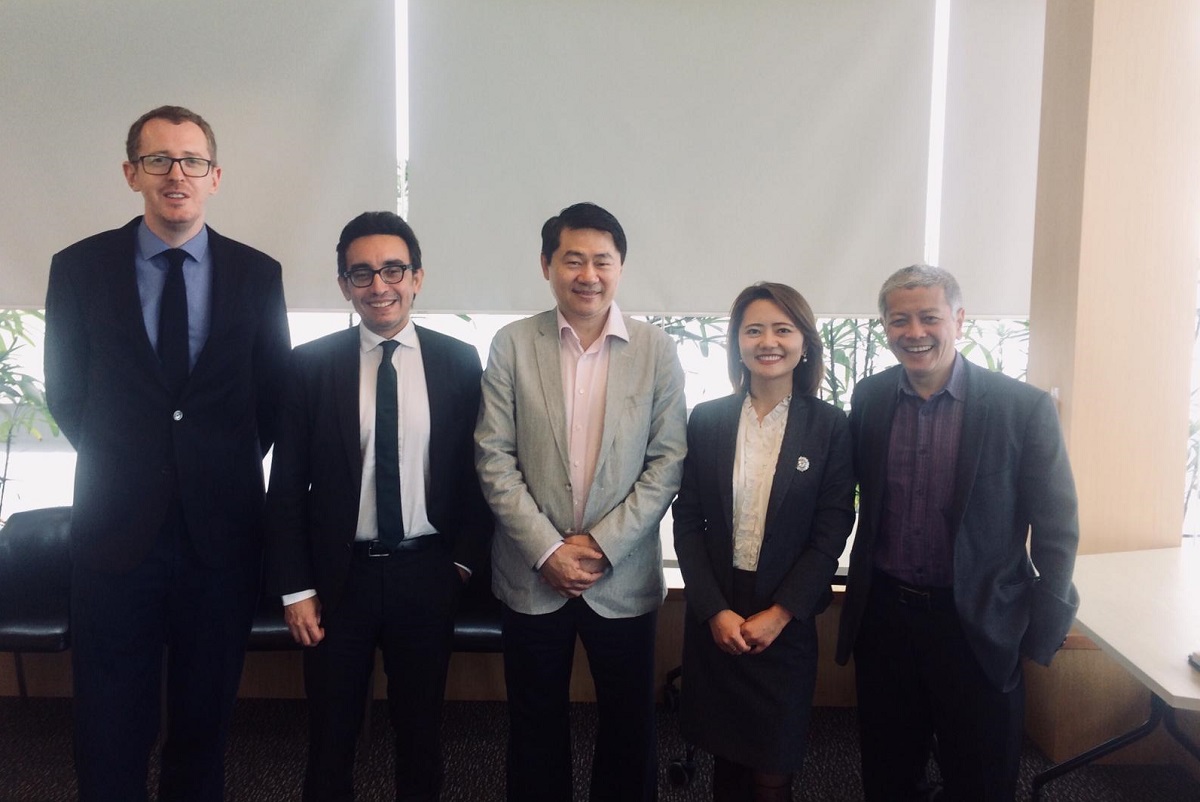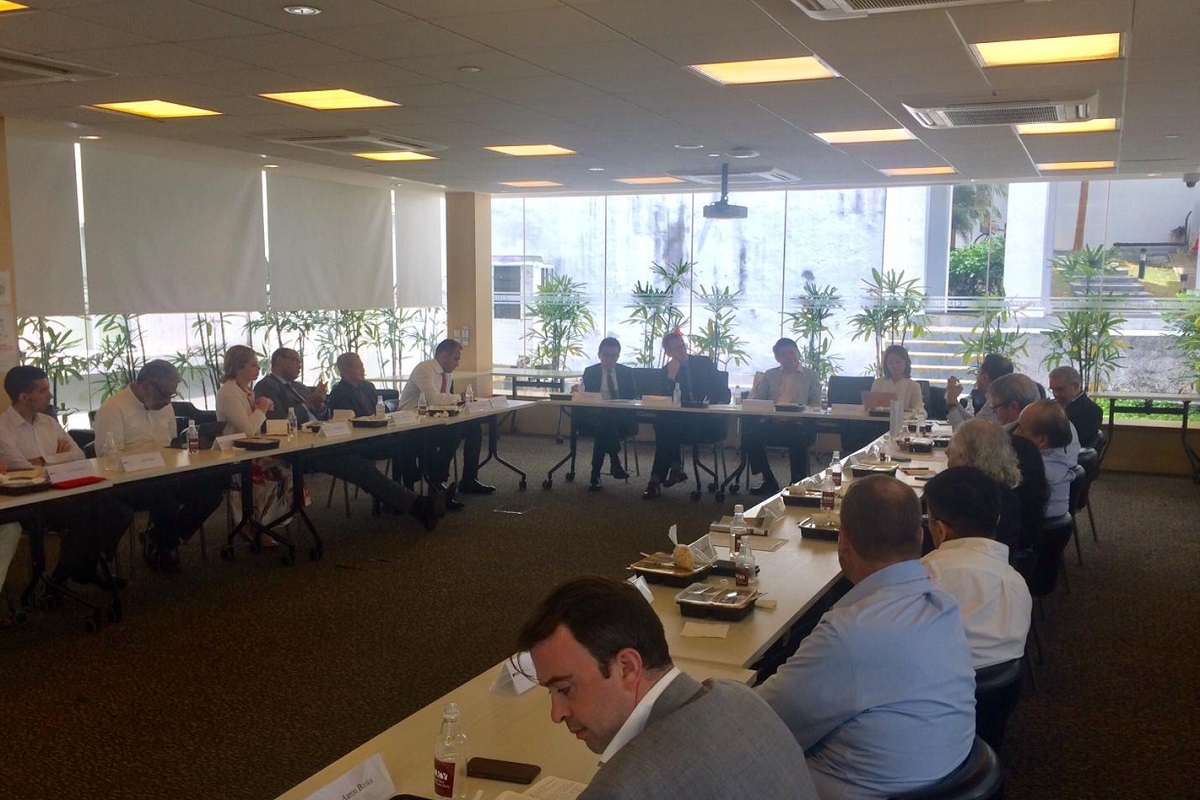
On July 25, 2019, Dr. Bruno Maçães, author of Belt and Road: A Chinese World Order, presented at a roundtable held at the Centre on Asia and Globalisation, on the theme of China’s Belt and Road Initiative (BRI) and its future development in the aftermath of the second BRI Forum, held in Beijing in April 2019.
Dr. Wang Huiyao, Henry, President of the Center for China and Globalization in Beijing, and Dr. Xue Gong, Research Fellow of the China Programme at the S. Rajaratnam School of International Studies (RSIS), responded to his presentation. The event was held under the Chatham House rule, but the following points were made by presenters and participants during the discussion.
- While there are many different interpretations of the BRI’s purpose and ultimate goal, a widely held view sees the project as an attempt to construct a Chinese-led “world order”. On this reading, the BRI is not merely designed to create infrastructure projects, but also to boost China’s trade growth and technological advancement, in part by developing Chinese-led global value chains.
- Beyond access to external markets, the BRI also allows China to become an international standard setter in certain areas. BRI programmes have helped Chinese companies such as Huawei gain favour in foreign markets.
- A range of criticisms were aimed at the BRI during 2018, especially over the issue of debt, leading some to suggest China might eventually abandon or downplay the programme. This scenario is unlikely, not least because China’s elite knows that access to world markets and the development of Chinese global value chains remain important to the country’s future growth.
- In future, the BRI will have important implications for China’s domestic economy and those of its neighbours. For instance, Beijing might decide to outsource its steel industry to various BRI partner countries, focusing its domestic market on higher value sectors.
- China's justifications and explanations for the BRI have changed over time. There is a division between the caution with which recipient governments treat the BRI in public, and their enthusiasm in private to secure new investment. Despite this, the BRI remains popular amongst most recipient countries. China’s ability to persuade Italy to join the BRI in 2019 was significant, given that it was the first G7 nation to participate.
- For many countries, confusion and suspicion remains about China’s ultimate purpose in developing the BRI. Some suspect China’s goal is not simply mutual economic development or “win-win cooperation”. Rather, they worry that BRI projects will end up being used for military or strategic purposes, and worry that the BRI is actually part of a wider strategic plan to win international primacy, ultimately by replacing the US as the world’s preeminent power.
- Following the 2019 Belt and Road Forum, China committed to make the BRI more multilateral. However, the extent of this new multilateralism remains unclear. More third-party cooperation within the BRI would leave China with less leeway on specific projects, constraining policymakers in Beijing. The 2nd BRI Forum involved greater participation from business leaders, reflecting what China suggests will be a greater role for the private sector in the BRI’s future development.
- The BRI’s governance could be improved through the creation of an international secretariat, to which, participating countries could send representatives. International financial institutions could create a joint platform with the BRI, allowing partner countries to take loans, but with international standards of governance. China could join the Paris Club, a group of creditor nations, to make its loans more transparent.
- The BRI could also in future become a platform for deals between third countries. For instance, a project set up between Pakistan and Uzbekistan could take place under the BRI banner, possibly using Chinese financing.
- Besides “multilateral” cooperation, China may also benefit from engaging in “mini-lateral” cooperation with small groups of countries to solve specific problems. For instance, in the Greater Mekong Subregion, China’s investment in infrastructure has come along with the development of new regional cooperation mechanisms.
- The BRI remains vulnerable to domestic political changes in recipient countries. Its lack of transparency may encourage rent-seeking behavior by China’s state-owned enterprises (SOEs), while its sizable funding also provides opportunities for corruption among domestic elites in recipient countries.
- These issues have already prompted reflection in Beijing, with China’s central government trying to gain a better understanding of the impact and flaws of the BRI’s existing model. In part because of this, the BRI’s initial phase of rapid expansion is likely to be over.
- New standards in areas like governance and sustainability are also gradually being mapped out. Instead of just large-scale infrastructure projects, there is likely in future to be a greater focus on investments in areas like new technology, especially in Southeast Asia.
- China's domestic politics are likely to affect the BRI’s future development. While it remains difficult to verify, some evidence seems to show that the BRI is domestically unpopular within China, given that it involves sending money abroad. China’s anti-corruption campaigns might also indirectly discourage future investment into the BRI, as they may reduce opportunities for rent-seeking by SOEs.
- The BRI prompts different responses in different countries, many of which have deep historical roots. Some partner nations have little sense of themselves as participants in the ancient Silk Road, and therefore are less enthusiastic about a contemporary project with which they do not culturally or historically identify.
- Despite its public prominence, the BRI alone will not come close to meeting future demands for new infrastructure around Asia. That said, the BRI can serve as a compliment to other regional connectivity projects.
- Despite its high profile, the BRI is not essential to China’s economic development. Many nations emerged as developed economies prior to the development of global value chains, and it is possible China could do the same, especially as China has of late become less reliant on exports to global markets.

****
Roundtable Participants
Prof. Kanti Bajpai, Director, Centre on Asia and Globalisation and Wilmar Professor of Asian Studies, Lee Kuan Yew School of Public Policy
Aaron Banks, Economic and Political Affairs section at U.S. Embassy Singapore
Dr. Bruno Maçães, author of Belt and Road: A Chinese World Order
H.E. Flavio Damico, Ambassador of Brazil
James Crabtree, Associate Professor in Practice, Lee Kuan Yew School of Public Policy (Chair)
Dr. James Dorsey, Senior Fellow, S. Rajaratnam School of International Studies
H.E. Bruce Gospar, High Commissioner of Australia
Dr. Selina Ho, Assistant Professor, Lee Kuan Yew School of Public Policy
Christian Jack, Second Secretary, Australian High Commission
Dr. Marina Kaneti, Assistant Professor, Lee Kuan Yew School of Public Policy
Dr. Prakash Kannan, Chief Economist, GIC
Prof. Khong Yuen Foong, Vice Dean, Lee Kuan Yew School of Public Policy
Lee Chor Pharn, Principal Strategist, Strategy Group, Centre for Strategic Futures
Dr. Adam Liu, Assistant Professor, Lee Kuan Yew School of Public Policy
Prof. Kishore Mahbubani, Distinguished Fellow, Asia Research Institute, National University of Singapore
Francesco Mancini, Associate Dean, Lee Kuan Yew School of Public Policy
Miao Lu (Mabel) , Co-founder, Vice President of the Center for China and Globalization
Prof. Raja Mohan, Director, Institute of South Asian Studies, National University of Singapore
Prof. Danny Quah, Dean, Lee Kuan Yew School of Public Policy
Dr. Teresita Cruz-Del Rosario, Adjunct Research Fellow, Asian Research Institute, National University of Singapore
Dr. Rahul Sagar, Associate Professor, New York University Abu Dhabi
Drew Thompson, Senior Research Fellow, Lee Kuan Yew School of Public Policy
Dr. Wang Huiyao (Henry), Founder and President of the Center for China and Globalization
Xu Shengwei, Research Assistant, Lee Kuan Yew School of Public Policy
Dr. Xue Gong, China Programme Research Fellow, S. Rajaratnam School of International Studies